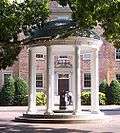Silent Sam
Coordinates: 35°54′50.22″N 79°3′8.55″W / 35.9139500°N 79.0523750°W
| Silent Sam | |
| University of North Carolina at Chapel Hill | |
|---|---|
 | |
| Erected | 1913 |
| Location | Chapel Hill, North Carolina |
| Website | http://www.unc.edu/tour/LEVEL_2/sam.htm |
Silent Sam is a statue of a Confederate soldier by John Wilson on the campus of the University of North Carolina at Chapel Hill.[1] It is located on McCorkle Place, the university's upper quad; facing Franklin Street on the northern edge of campus.[2]
The statue was funded by the University Alumni and the United Daughters of the Confederacy. It was erected in 1913 as a memorial to the 321 alumni who lost their lives in the American Civil War and all students who joined the Confederate States Army.[3] More than one thousand members of the university fought in the American Civil War in either the Northern or Southern armies, comprising at least 40% of the student body, a statistic that was unequaled by any other school. [4] The University remained open through the entire war. This was due to President Swain's policy of dependency on men unfit for combat.[5] A bronze image on the front of the memorial depicts a young student dropping his books as he looks up to answer a call to duty. Under the student, a woman meant to signify North Carolina is depicted advising students to fight for an important cause even if it means leaving their studies.[6] The statue was made to commemorate 50 years since the beginning of the war (1911).[7]

The United Daughters of the Confederacy spent four years fundraising and hired Canadian sculptor John Wilson to create the statue. The statue cost the Daughters of the Confederacy $7,500.[8]
Similar to the sculpture Wilson created of an unarmed Union soldier Daniel A. Bean, Wilson created a "silent" statue by not including a cartridge box on the Confederate soldier's belt so he cannot fire his gun.[9] Like the Daniel A. Bean sculpture, Wilson used a northerner--Harold Langlois, a Boston man, as his model.[8]
Wilson created a series of similar statues called the "Silent Sentinels." All were created in the North and then displayed in the South. Like these other statues, Silent Sam is positioned to face north towards the Union, rather than towards the Confederacy.[8]
Like its neighbor, the Unsung Founders Memorial, the Silent Sam statue has frequently been a source of controversy. It is seen by some as symbol of historical remembrance, while others view it as a sign of racial oppression. The monument has been a subject of controversy and a site of protest since the 1960s. In March 1965, a discussion about the monument's meaning and history occurred in the letters to the editor of the UNC student newspaper, the Daily Tar Heel. [10] In May 1967, poet John Beecher "debated" Silent Sam, reading to the statue from his book of poetry To Live and Die in Dixie. [11] Following the assassination of Martin Luther King, Jr. in April 1968, the monument was vandalized. [12] In the early 1970s, the monument was the site of several demonstrations by the Black Student Movement.[13]
Students gathered by the statue to speak out after Los Angeles police officers were found not guilty in the 1992 Rodney King trial.[14] In 1997, a Martin Luther King, Jr. Day march focused on issues facing UNC housekeepers ended at the monument.[15]
Controversy
In July 2015, the statue was vandalized. The statue has been the focus of protests and many have called for its removal. [16] A UNC history professor, Dr. Harry Watson, reported in a Daily Tar Heel article that he believes the monument is an important part of the campus history, but that the belief about the statue promotes a false idea about the Civil War.[17]
Many of the more recent protests have been due to the rise in police violence and police brutality against minorities and the string of violence in the last five years that has resulted in a rising death toll for the black community. The "Black Lives Matter" movement has been one result of such protests.
References
- ↑ Light on the Hill: A History of the University of North Carolina At Chapel Hill By William D. Snider, p. 148
- ↑ "The Civil War Years." The Carolina Story: A Virtual Museum of University History. Retrieved on March 1, 2008.
- ↑ http://www.unc.edu/interactive-tour/silent-sam/
- ↑ http://www.washingtonmonthly.com/college_guide/blog/silent_violent_racist_sam.php
- ↑ http://www.unc.edu/interactive-tour/silent-sam/
- ↑ http://museum.unc.edu/exhibits/public_art/confederate_memorial/
- ↑ United Daughters of the Confederacy p. 66
- 1 2 3 "UNC's Silent Sam and Honoring the Confederacy". We're History. Retrieved 2016-01-26.
- ↑ ."Silent Sam (Civil War Monument)." The University of North Carolina at Chapel Hill Virtual Tour. Retrieved on March 1, 2008.
- ↑ "Timeline". A Guide to Resources on UNC's Confederate Monument. Retrieved 24 June 2016.
- ↑ "Timeline". A Guide to Resources on UNC's Confederate Monument. Retrieved 24 June 2016.
- ↑ "Timeline". A Guide to Resources on UNC's Confederate Monument. Retrieved 24 June 2016.
- ↑ "Timeline". A Guide to Resources on UNC's Confederate Monument. Retrieved 24 June 2016.
- ↑ "Silent Sam." The Weiss Urban Livability Program. Retrieved on March 1, 2008.
- ↑ "Timeline". A Guide to Resources on UNC's Confederate Monument. Retrieved 24 June 2016.
- ↑ 'Silent Sam' Confederate Statue At UNC Vandalized
- ↑ http://www.dailytarheel.com/article/2015/07/narratives-about-silent-sam-collide
